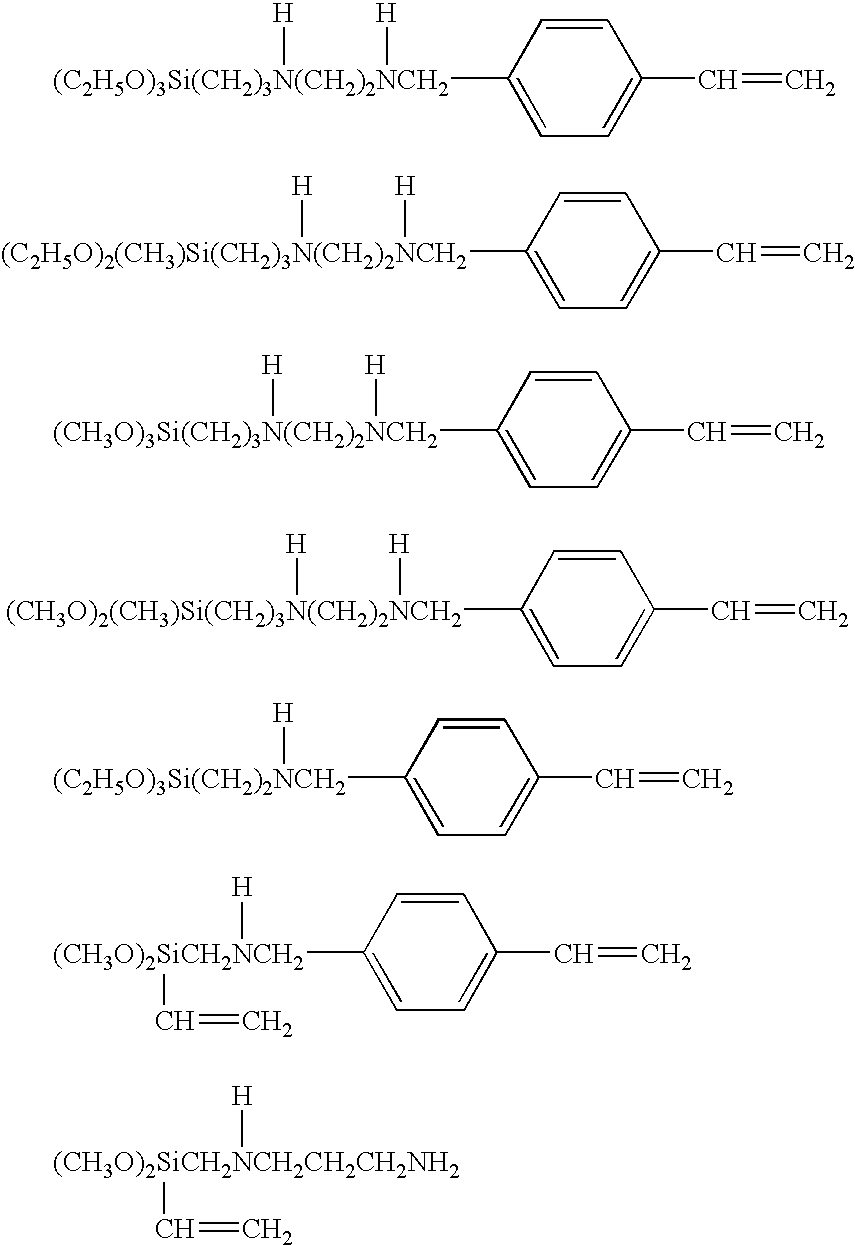Anti-tracking silicone rubber composition and power cable using the same
a technology of silicone rubber and composition, which is applied in the direction of power cables, insulated conductors, cables, etc., can solve the problems of unsuitable power cable connection, lack of mechanical strength, and easy tracking of silicone rubber, so as to improve mechanical strength, improve high-voltage electrical insulation, and reduce the tensile permanent set
- Summary
- Abstract
- Description
- Claims
- Application Information
AI Technical Summary
Benefits of technology
Problems solved by technology
Method used
Image
Examples
example 1
[0047]On a kneader, 95 parts by weight of an organopolysiloxane consisting of 99.975 mol % dimethylsiloxane units and 0.025 mol % dimethylvinylsiloxane units and having an average degree of polymerization of about 8,000, 5 parts by weight of an organopolysiloxane consisting of 89.993 mol % dimethylsiloxane units, 9.982 mol % methylvinylsiloxane units and 0.025 mol % dimethylvinylsiloxane units and having an average degree of polymerization of about 8,000, 40 parts by weight of fumed silica having a specific surface area of 200 m2 / g (Aerosil 200 by Nippon Aerosil Co., Ltd.), 5 parts by weight of hexamethyldisilazane as a dispersant, and 1 part by weight of water were mixed. The mixture was further combined with 1.0 part by weight of an organopolysiloxane of formula (3) shown below, designated Polymer A, hereinafter, and heat treated at 180° C. for 3 hours, yielding Compound A.
[0048]On a twin-roll mill, 100 parts by weight of Compound A was compounded with 0.1 part by weight of a 2-e...
example 2
[0050]On a kneader, 95 parts by weight of an organopolysiloxane consisting of 99.975 mol % dimethylsiloxane units and 0.025 mol % dimethylvinylsiloxane units and having an average degree of polymerization of about 8,000, 5 parts by weight of an organopolysiloxane consisting of 89.993 mol % dimethylsiloxane units, 9.982 mol % methylvinylsiloxane units and 0.025 mol % dimethylvinylsiloxane units and having an average degree of polymerization of about 8,000, 35 parts by weight of fumed silica having a specific surface area of 300 m2 / g which had been made hydrophobic through treatment with dichlorodimethylsilane, and 3 parts by weight of a silanol-terminated dimethylpolysiloxane having an average degree of polymerization of 13 and a viscosity of 15 cs at 25° C. as a dispersant were mixed. The mixture was further combined with 1.0 part by weight of Polymer A and heat treated at 180° C. for 3 hours, yielding Compound B.
[0051]On a twin-roll mill, 100 parts by weight of Compound B was compo...
example 3
[0053]On a twin-roll mill, 100 parts by weight of Compound B (prepared in Example 2) was compounded with 0.1 part by weight of a 2-ethylhexanol solution of chloroplatinic acid hexahydrate (platinum concentration 2 wt %), 1.0 part by weight of iron oxide, 5.0 parts by weight of titanium oxide, 0.5 part by weight of cerium oxide and 1 part by weight of a trimethylsiloxy-terminated silicone oil consisting of 75 mol % dimethylsiloxane units and 25 mol % diphenylsiloxane units and having a viscosity of 400 cs. Further, 0.6 part by weight of dicumyl peroxide as a curing agent was incorporated on the twin-roll mill, yielding a silicone rubber composition SRC3.
[0054]From this composition SRC3, a cured rubber sheet specimen was similarly prepared. The measured properties of the cured specimen are shown in Table 1.
PUM
| Property | Measurement | Unit |
|---|---|---|
| Fraction | aaaaa | aaaaa |
| Percent by mass | aaaaa | aaaaa |
| Percent by mass | aaaaa | aaaaa |
Abstract
Description
Claims
Application Information
 Login to View More
Login to View More - R&D
- Intellectual Property
- Life Sciences
- Materials
- Tech Scout
- Unparalleled Data Quality
- Higher Quality Content
- 60% Fewer Hallucinations
Browse by: Latest US Patents, China's latest patents, Technical Efficacy Thesaurus, Application Domain, Technology Topic, Popular Technical Reports.
© 2025 PatSnap. All rights reserved.Legal|Privacy policy|Modern Slavery Act Transparency Statement|Sitemap|About US| Contact US: help@patsnap.com



